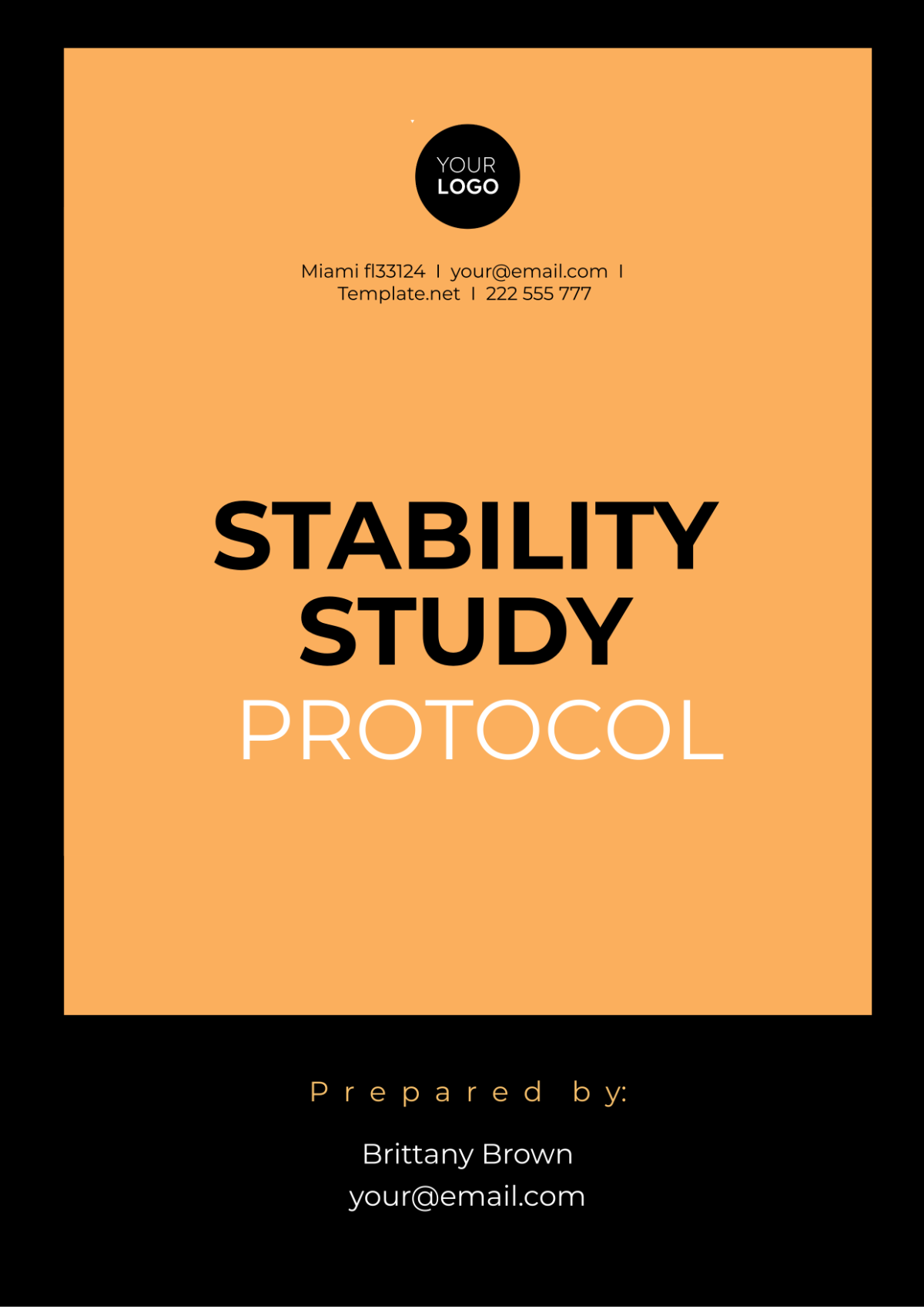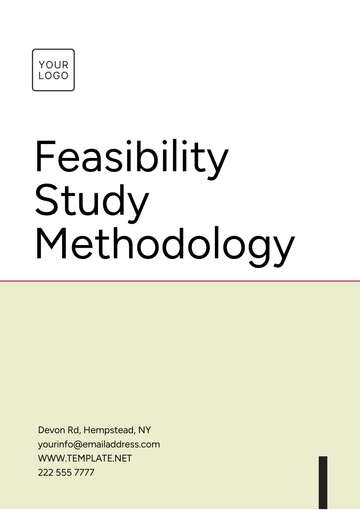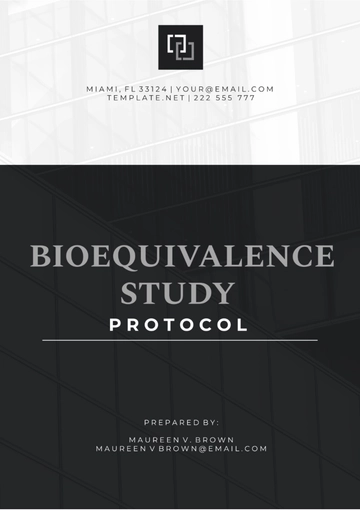STABILITY STUDY PROTOCOL
Name: | [YOUR NAME] |
|---|
Company: | [YOUR COMPANY NAME] |
|---|
Date: | [DATE] |
|---|
I. Objectives
The objective of this Stability Study Protocol is to establish and define the process of conducting stability studies at [Your Company Name]. This process will aid in assessing and evaluating the stability of [Your Product] under specified environmental conditions and provide valuable insights into how its quality evolves.
Furthermore, the protocol aims to define shelf-life and expiration dates, ensuring the effectiveness, safety, and reliability of [Your Product] throughout its shelf-life for the satisfaction and safety of end users.
II. Protocol Overview
The Stability Study Protocol outlines the procedures, methodologies, storage conditions, and analytical methods for testing [Your Product] at [Your Company Name]. It investigates behavioral changes over time under specific conditions, determining its lifespan and integrity.
Site Selection Criteria: Sites selected for the study must meet environmental stability requirements consistent with product usage conditions. Factors such as temperature control, humidity levels, and exposure to light are critical considerations.
Study Duration Considerations: The duration of the study should reflect [Your Product]'s expected shelf-life and regulatory requirements. Longer durations may be necessary for products with extended stability profiles, while accelerated testing may be applicable for rapid assessment.
Test Conditions Specifications: Defined test conditions encompass a range of environmental variables, including temperature ranges, humidity levels, and light exposure, tailored to mimic real-world storage and usage scenarios.
Batch Number Requirements: Each batch of [Your Product] subjected to stability testing must be uniquely identified and tracked to ensure traceability and data integrity throughout the study.
Sample Size Determinants: Sample size determination considers statistical significance, variability within batches, and regulatory guidelines to ensure representative sampling and reliable results.
Testing Frequency Details: The frequency of testing intervals, ranging from weeks to months, is determined based on product stability expectations, storage conditions, and regulatory requirements. More frequent testing may be necessary during critical stability periods.
III. Procedure
Assigned Responsibilities | Description |
|---|
Quality Assurance (QA) | Clearly define roles and responsibilities for QA personnel involved in the stability study. |
Research and Development (R&D) | Define roles and responsibilities for R&D personnel conducting the stability study. |
Quality Control (QC) | Outline roles and responsibilities for QC personnel monitoring and verifying study adherence. |
Required Materials | Specify the materials and equipment needed for sample preparation, testing, and data collection. |
Sample Handling | Outline procedures for sample collection, labeling, storage, and retrieval to maintain sample integrity. |
Testing Procedures | Describe specific testing protocols, including conditions, intervals, methods, and acceptance criteria. |
Documentation Processes | Detail requirements for recording test results, deviations, and corrective actions during the study. |
Storage Conditions | Specify storage conditions, including temperature, humidity, and light exposure, for consistent testing environments. |
Study Duration | Define the duration of the stability study based on shelf-life, regulatory requirements, and testing frequency. |
Analytical Methods | Outline validated methods for analyzing stability samples, ensuring accuracy and reliability of results. |
Deviations from Procedures | Document any deviations, including justifications and corrective actions to maintain data integrity. |
IV. Data Collection
Data Types: Identify and categorize data types, including qualitative and quantitative data such as temperature logs, humidity levels, physical stability results, and chemical stability results of [Your Product].
Collection Methods: Describe the methods used to collect data, ensuring accuracy, consistency, and relevance to the stability study objectives.
Analysis: Specify the analysis approach for both qualitative and quantitative data, including statistical methods, trend analysis, and comparison against predefined acceptance criteria.
Temperature Logs: Record and monitor temperature fluctuations throughout the study period, documenting any deviations from specified storage conditions.
Humidity Levels: Measure and track humidity levels to assess their impact on product stability and integrity.
Stability Results: Collect and analyze stability testing results, including physical attributes, chemical composition, and performance characteristics of [Your Product].
V. Safety Considerations
The Safety Considerations section highlights safety measures for the Stability Study at [Your Company Name]:
Safety Standards: Adhere to established safety standards and guidelines applicable to the handling and testing of [Your Product].
Guidelines: Follow specific guidelines for handling hazardous materials, equipment, and chemicals during the stability study.
Emergency Procedures: Develop and document detailed emergency procedures, including evacuation plans, spill response protocols, and medical emergency protocols, to ensure the safety of personnel.
Hazardous Sample Handling: Implement safe handling practices for hazardous samples, including proper labeling, containment, and disposal procedures.
Team Wellbeing: Prioritize the wellbeing of the team involved in the stability study by providing necessary safety training, personal protective equipment (PPE), and regular safety inspections.
Specific Instructions: Provide specific instructions for handling hazardous samples or working in potentially dangerous conditions, including precautions to minimize risks and prevent accidents.
VI. Expected Results
The Expected Results section anticipates the product's stability over time and discusses possible outcomes based on the applied conditions in the stability study. It provides an estimation of [Your Product]'s behavior and performance characteristics under these conditions.
Stability Assessment: Discuss the expected changes in [Your Product]'s physical, chemical, and performance attributes over the study duration. This includes parameters such as color, texture, pH, potency, and degradation profiles.
Shelf-Life Estimation: Estimate the product's shelf-life based on stability testing data and regulatory requirements. This estimation considers factors like degradation rates, storage conditions, and product integrity.
Safety and Efficacy: Evaluate the product's safety and efficacy under different storage conditions and durations. This includes assessing any potential changes in potency, bioavailability, and product functionality.
Trend Analysis: Analyze trends observed during stability testing, such as degradation kinetics, accelerated aging effects, and stability-indicating parameters. Use statistical methods to extrapolate long-term stability trends.
Quality Attributes: Assess changes in quality attributes, including physical appearance, chemical composition, microbial stability, and overall product quality.
Regulatory Compliance: Ensure that expected results align with regulatory requirements for product stability, safety, and efficacy. Discuss any deviations from expected outcomes and their implications on regulatory compliance.
VII. Conclusion
The conclusion of the Stability Study Protocol provides a concise analysis of the study findings, highlighting key observations regarding [Your Product]'s stability and quality attributes. Based on these findings, actionable recommendations are offered to enhance product stability, optimize storage conditions, and ensure regulatory compliance. The conclusion also outlines future actions, such as additional testing or monitoring, to maintain [Your Product]'s quality and efficacy over time.
Protocol Templates @ Template.net






























